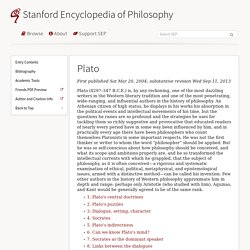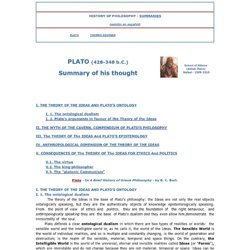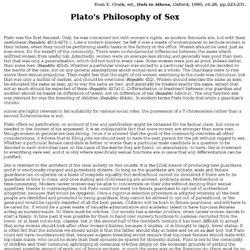

Plato. 1.

Plato's central doctrines Many people associate Plato with a few central doctrines that are advocated in his writings: The world that appears to our senses is in some way defective and filled with error, but there is a more real and perfect realm, populated by entities (called “forms” or “ideas”) that are eternal, changeless, and in some sense paradigmatic for the structure and character of the world presented to our senses. Among the most important of these abstract objects (as they are now called, because they are not located in space or time) are goodness, beauty, equality, bigness, likeness, unity, being, sameness, difference, change, and changelessness.
(These terms—“goodness”, “beauty”, and so on—are often capitalized by those who write about Plato, in order to call attention to their exalted status; similarly for “Forms” and “Ideas.”) 2. 3. We are of course familiar with the dialogue form through our acquaintance with the literary genre of drama.
Summary of Plato. I.

The ThEORy OF The IDEAS And PLATO’S ONTOLOGY I. 1. The ontological dualism The theory of the Ideas is the base of Plato’s philosophy: the Ideas are not only the real objects ontologically speaking, but they are the authentically objects of knowledge epistemologically speaking. From the point of view of ethics and politics , they are the foundation of the right behaviour, and anthropologically speaking they are the base of Plato’s dualism and they even allow him demonstrate the immortality of the soul. Plato defends a clear ontological dualism in which there are two types of realities or worlds: the sensible world and the intelligible world or, as he calls it, the world of the Ideas.
The Ideas are hierarchically ordered; there are different types and they do not have all the same value. Philosophy of Education. Philosophy and Art in Plato's Republic. Aesthetics - Plato's Aesthetics. Plato had a love-hate relationship with the arts.

He must have had some love for the arts, because he talks about them often, and his remarks show that he paid close attention to what he saw and heard. He was also a fine literary stylist and a great story-teller; in fact he is said to have been a poet before he encountered Socrates and became a philosopher. Some of his dialogues are real literary masterpieces. On the other hand, he found the arts threatening. He proposed sending the poets and playwrights out of his ideal Republic, or at least censoring what they wrote; and he wanted music and painting severely censored.
Plato's influence on western culture generally is a very strong one, and this includes a strong influence on the arts, and on theories of art. Plato saw the changing physical world as a poor, decaying copy of a perfect, rational, eternal, and changeless original. Beauty, Justice, and The Circle are all examples of what Plato called Forms or Ideas. 1. 2. Back to top. Plato's Philosophy of Sex. From E.

Craik, ed., Owls to Athens , Oxford, 1990, ch.26, pp.223-231. Plato was the first feminist. Only, he was concerned not with women's rights, as modern feminists are, but with their usefulness ( Republic 451b-457b.). Like a modern planner, he felt it was a waste of woman-power to seclude women in their homes, when they could be performing useful tasks in the factory or the office. Women should be used, just as men were, for the benefit of the community. Somes are highly relevant to his suitability for various social roles, the possession of a Y-chromosome rather than a second X-chromosome is not. Plato offers no justification, or account of how any justification might be obtained for his factual claim, but none is needed in the context of his argument.
Sex is relevant to the architect of the ideal society on two counts: it is the [224] means of producing new guardians, and it is emotionally charged and potentially divisive. The community of wives and children solves both problems.